Abstract
In order to compare the clinical and microbiological efficacies and safety of piperacillin plus tazobactam with those of imipenem plus cilastatin, 134 patients with intra-abdominal infections (73 patients with appendicitis) participated in an open randomized comparative multicenter trial. A total of 40 men and 29 women (mean age, 53 years; age range, 18 to 92 years) were enrolled in the piperacillin-tazobactam group and 40 men and 25 women (mean age, 54 years; age range, 16 to 91 years) were enrolled in the imipenem-cilastatin group. The patients received either piperacillin (4 g) and tazobactam (500 mg) every 8 h or imipenem and cilastatin (500 mg each) every 8 h. Both regimens were given by intravenous infusion. A total of 113 patients were clinically evaluable. Of 55 patients who received piperacillin-tazobactam, 50 were clinically cured, while 40 of 58 patients in the imipenem-cilastatin group were clinically cured. The differences were significant (Wilcoxon test; P = 0.005). There were 4 failures or relapses in the piperacillin-tazobactam group and 18 failures or relapses in the imipenem-cilastatin group. The microorganisms isolated were eradicated in similar proportions in the two patient groups. Adverse reactions, mainly gastrointestinal disturbances and nausea, were noted in 13 patients who received piperacillin-tazobactam and in 14 patients who received imipenem-cilastatin. Results of the present study show that piperacillin-tazobactam is effective and safe for the treatment of intra-abdominal infections.
Full text
PDF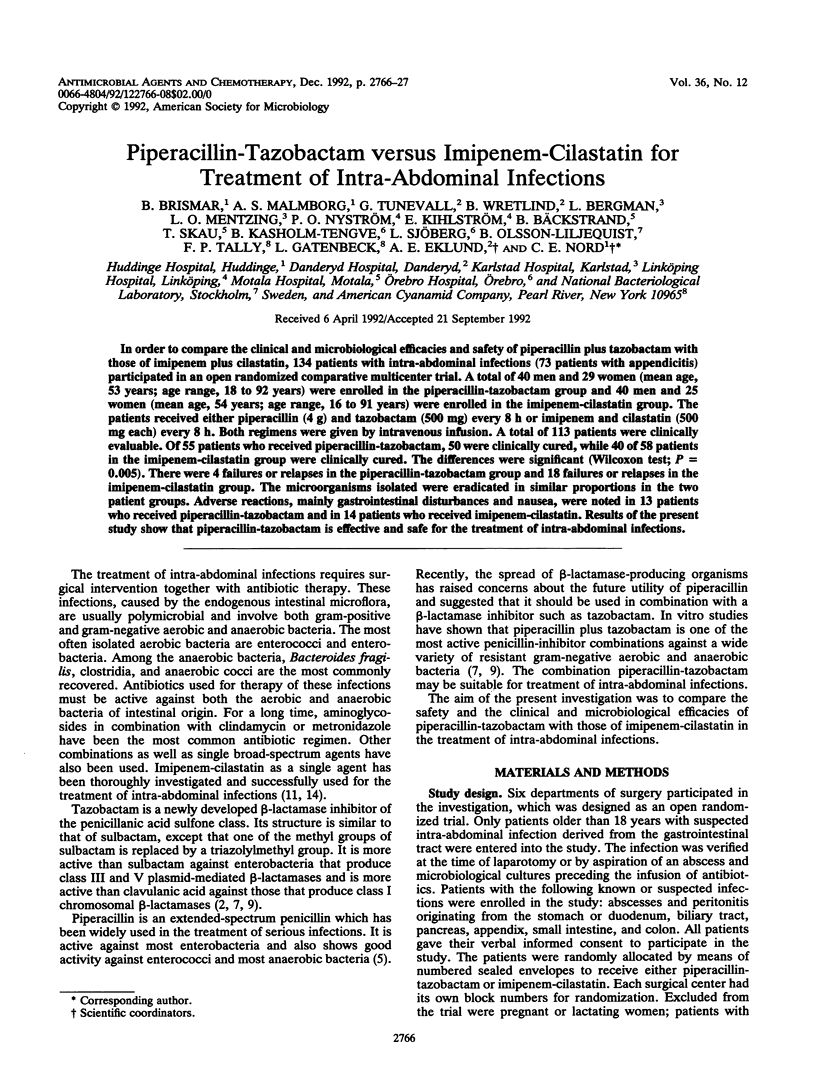
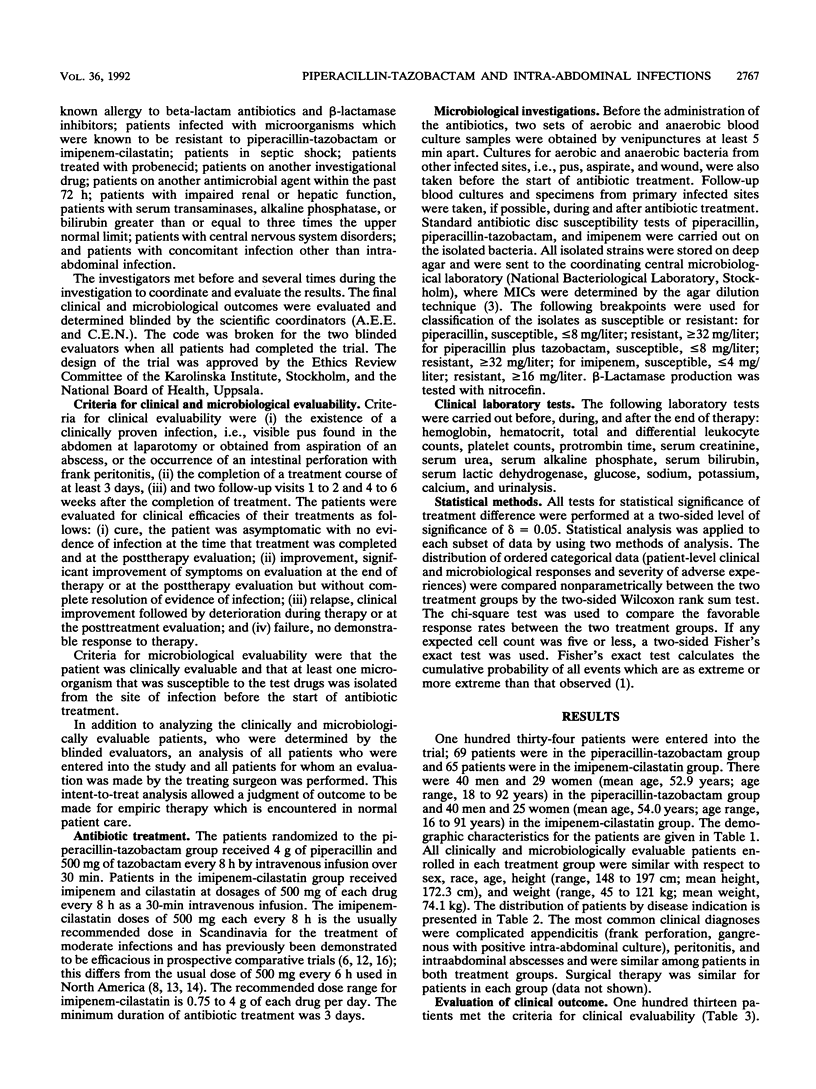
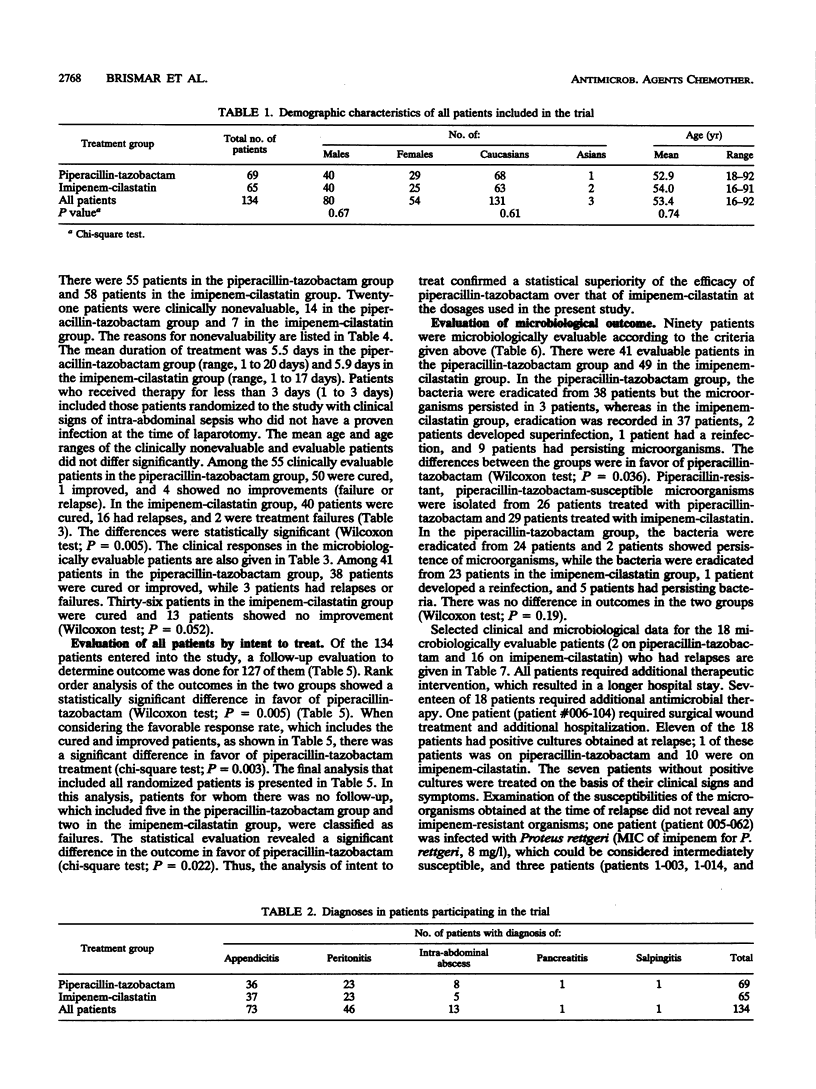
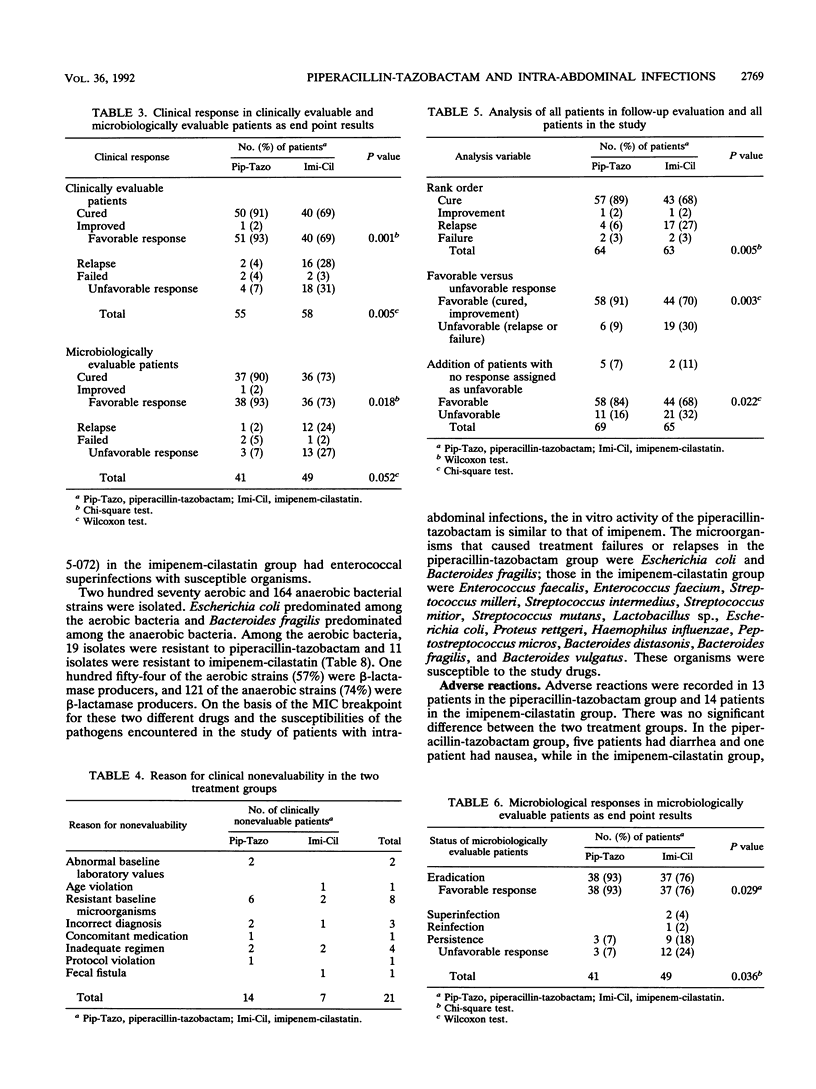
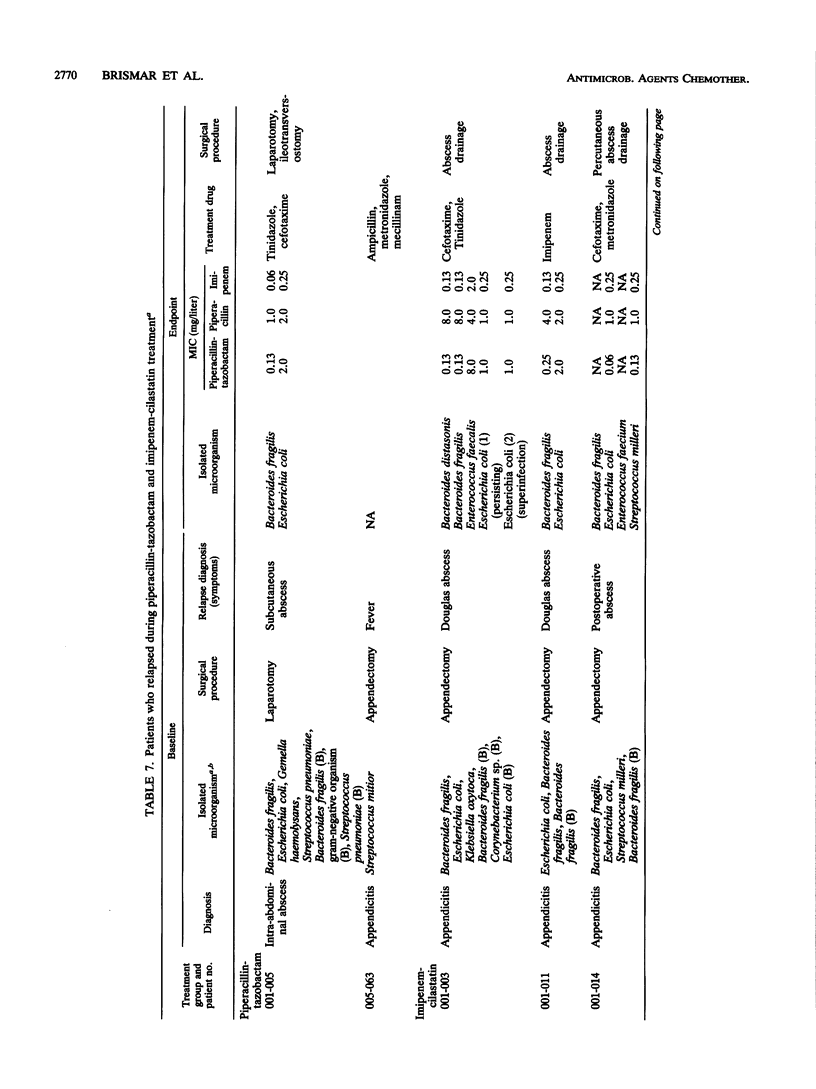

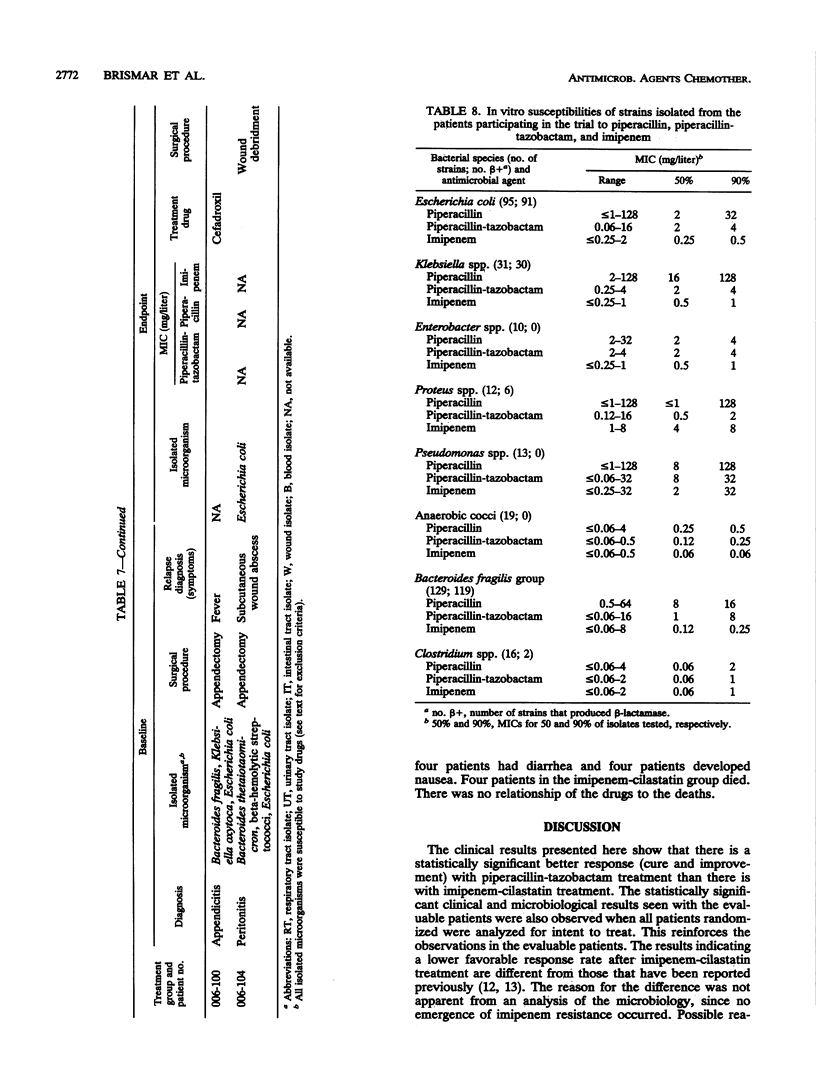
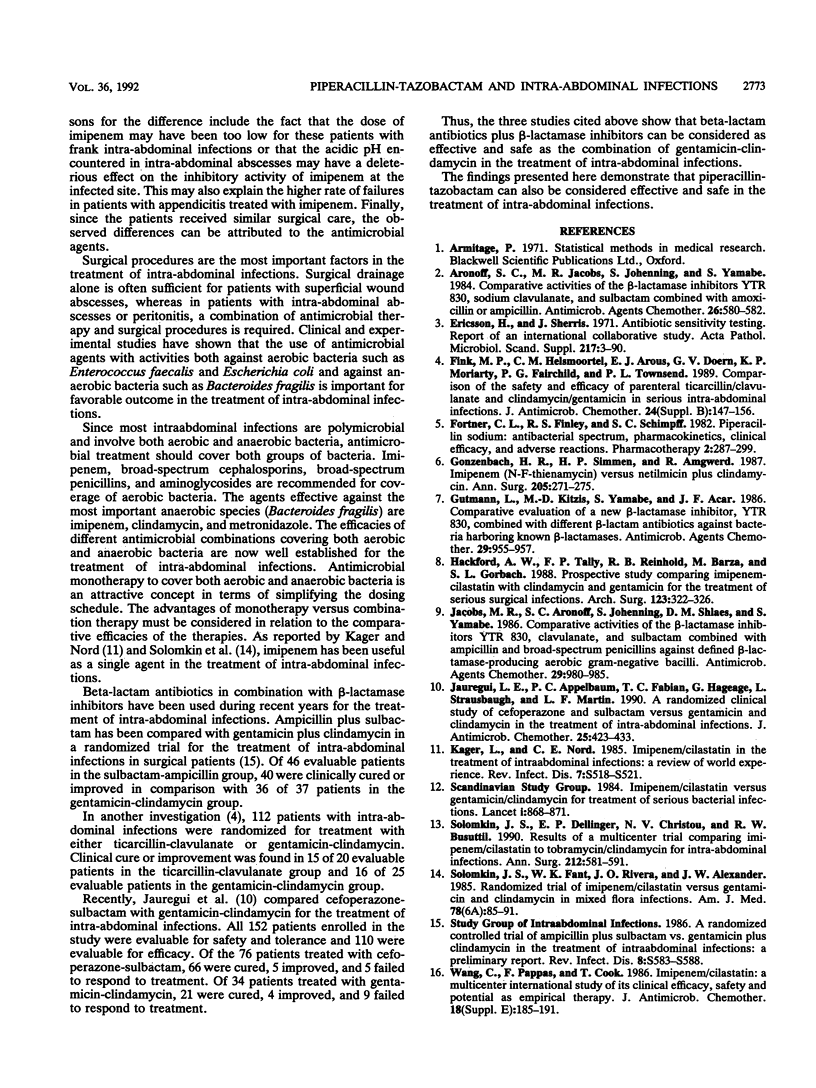
Selected References
These references are in PubMed. This may not be the complete list of references from this article.
- Aronoff S. C., Jacobs M. R., Johenning S., Yamabe S. Comparative activities of the beta-lactamase inhibitors YTR 830, sodium clavulanate, and sulbactam combined with amoxicillin or ampicillin. Antimicrob Agents Chemother. 1984 Oct;26(4):580–582. doi: 10.1128/aac.26.4.580. [DOI] [PMC free article] [PubMed] [Google Scholar]
- Fink M. P., Helsmoortel C. M., Arous E. J., Doern G. V., Moriarty K. P., Fairchild P. G., Townsend P. L. Comparison of the safety and efficacy of parenteral ticarcillin/clavulanate and clindamycin/gentamicin in serious intra-abdominal infections. J Antimicrob Chemother. 1989 Nov;24 (Suppl B):147–156. doi: 10.1093/jac/24.suppl_b.147. [DOI] [PubMed] [Google Scholar]
- Fortner C. L., Finley R. S., Schimpff S. C. Piperacillin sodium: antibacterial spectrum, pharmacokinetics, clinical efficacy, and adverse reactions. Pharmacotherapy. 1982 Nov-Dec;2(6):287–299. doi: 10.1002/j.1875-9114.1982.tb03202.x. [DOI] [PubMed] [Google Scholar]
- Gonzenbach H. R., Simmen H. P., Amgwerd R. Imipenem (N-F-thienamycin) versus netilmicin plus clindamycin. A controlled and randomized comparison in intra-abdominal infections. Ann Surg. 1987 Mar;205(3):271–275. doi: 10.1097/00000658-198703000-00009. [DOI] [PMC free article] [PubMed] [Google Scholar]
- Gutmann L., Kitzis M. D., Yamabe S., Acar J. F. Comparative evaluation of a new beta-lactamase inhibitor, YTR 830, combined with different beta-lactam antibiotics against bacteria harboring known beta-lactamases. Antimicrob Agents Chemother. 1986 May;29(5):955–957. doi: 10.1128/aac.29.5.955. [DOI] [PMC free article] [PubMed] [Google Scholar]
- Hackford A. W., Tally F. P., Reinhold R. B., Barza M., Gorbach S. L. Prospective study comparing imipenem-cilastatin with clindamycin and gentamicin for the treatment of serious surgical infections. Arch Surg. 1988 Mar;123(3):322–326. doi: 10.1001/archsurg.1988.01400270056008. [DOI] [PubMed] [Google Scholar]
- Jacobs M. R., Aronoff S. C., Johenning S., Shlaes D. M., Yamabe S. Comparative activities of the beta-lactamase inhibitors YTR 830, clavulanate, and sulbactam combined with ampicillin and broad-spectrum penicillins against defined beta-lactamase-producing aerobic gram-negative bacilli. Antimicrob Agents Chemother. 1986 Jun;29(6):980–985. doi: 10.1128/aac.29.6.980. [DOI] [PMC free article] [PubMed] [Google Scholar]
- Jauregui L. E., Appelbaum P. C., Fabian T. C., Hageage G., Strausbaugh L., Martin L. F. A randomized clinical study of cefoperazone and sulbactam versus gentamicin and clindamycin in the treatment of intra-abdominal infections. J Antimicrob Chemother. 1990 Mar;25(3):423–433. doi: 10.1093/jac/25.3.423. [DOI] [PubMed] [Google Scholar]
- Kager L., Nord C. E. Imipenem/cilastatin in the treatment of intraabdominal infections: a review of worldwide experience. Rev Infect Dis. 1985 Jul-Aug;7 (Suppl 3):S518–S521. doi: 10.1093/clinids/7.supplement_3.s518. [DOI] [PubMed] [Google Scholar]
- Solomkin J. S., Dellinger E. P., Christou N. V., Busuttil R. W. Results of a multicenter trial comparing imipenem/cilastatin to tobramycin/clindamycin for intra-abdominal infections. Ann Surg. 1990 Nov;212(5):581–591. doi: 10.1097/00000658-199011000-00004. [DOI] [PMC free article] [PubMed] [Google Scholar]
- Solomkin J. S., Fant W. K., Rivera J. O., Alexander J. W. Randomized trial of imipenem/cilastatin versus gentamicin and clindamycin in mixed flora infections. Am J Med. 1985 Jun 7;78(6A):85–91. doi: 10.1016/0002-9343(85)90106-8. [DOI] [PubMed] [Google Scholar]
- Wang C., Pappas F., Cook T. Imipenem/cilastatin: a multicentre international study of its clinical efficacy, safety and potential as empirical therapy. J Antimicrob Chemother. 1986 Dec;18 (Suppl E):185–191. doi: 10.1093/jac/18.supplement_e.185. [DOI] [PubMed] [Google Scholar]


